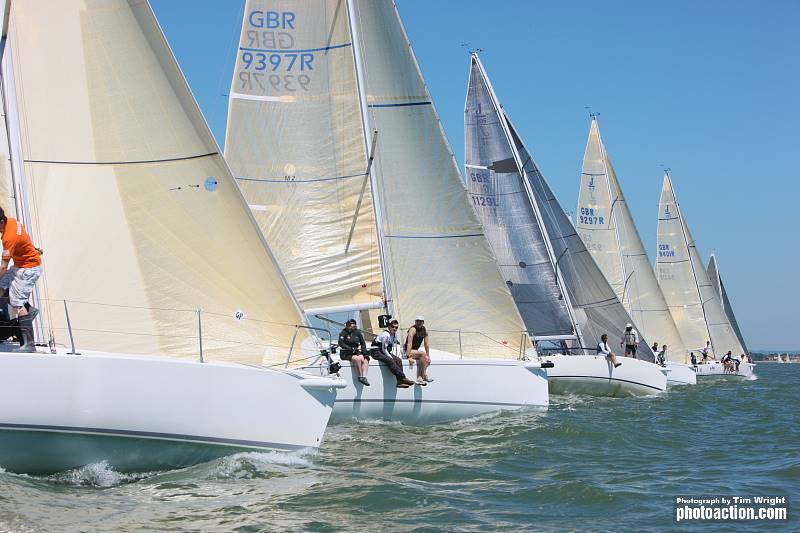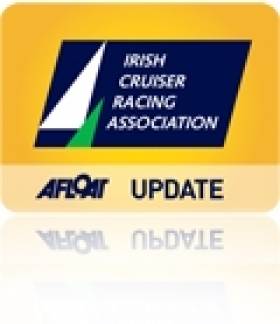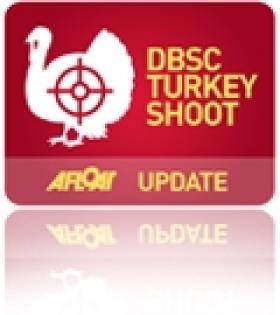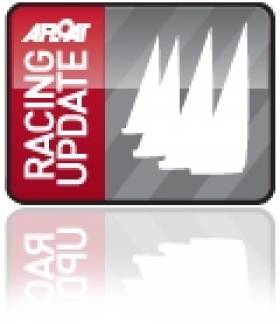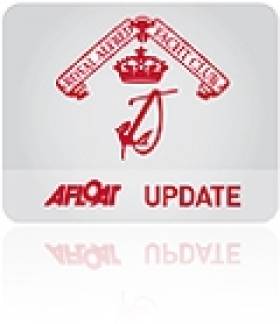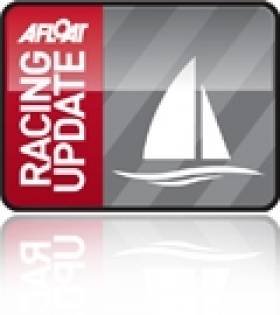Displaying items by tag: J109
Storm Wins ICRA Boat of Year Award
As predicted in Afloat's online reader poll Howth Yacht Storm (Pat Kelly) has lifted the Irish Cruiser Racer Association's Boat of the Year award at this afternoon's ICRA conference in Dun Laoghaire.
Among other wins, the J109 design counted five firsts in an impressive vistory in class one IRC at this year's ICRA Nationals held in Crosshaven.
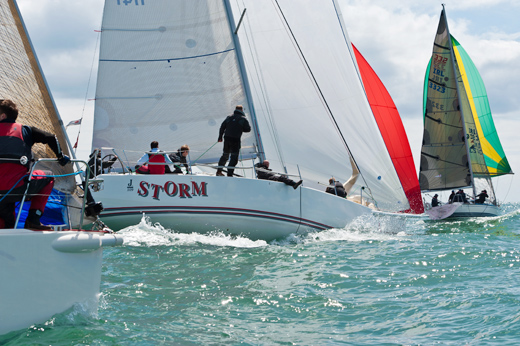
Boat of the Year Storm in winning style. Photo: Bob Bateman
National Yacht Club's Jalapeno Wins First Turkey Shoot Race
# DBSC TURKEY SHOOT – Two J109s shared the top slots in the first race of last Sunday's Dublin Bay Sailing Club Turkey Shoot, sponsored this year by Boatshed.com. National Yacht Club Commodore Paul Barrington's Jalapeno beat John Maybury's Joker II by over two minutes for the gun.
There was an impressive fleet of 57 starters who sailed in breeze, a bit of a sea and sunshine! Third was the A34 Another Advenure (Daragh Cafferkey).
Organiser Fintan Cairns has issued a reminder to compeititors to give 'plenty of room and time at all times' for next Sunday's race.
First Race Results below.
| 1 Jalapeno |
| 2 Joker 2 |
| 3 Another Adventure |
| 4 Adrenalin |
| 5 Jump the Gun |
| 6 Indecision |
| 7 Jetstream |
| 8 Jura |
| 9 Fflogger |
| 10 African Challenge |
| 11 Orna |
| 12 Windshift |
| 13= Violet Flame |
| 13= Karukera |
| 15 Pippa IV |
| 16 UCD Sailing |
| 17 Axiom |
| 18 Asterix |
| 19 Pink Ladies |
| 20 Miss Behavin |
| 21 Kamikaze |
| 22= Lula Belle |
| 22= Fiddly Bits |
| 24 Peridot |
| 25 Diamond |
| 26 Yoke |
| 27 Adelie |
| 28 Calypso |
| 29 Legally Blonde |
| 30 Cri-Cri |
| 31 White Knight |
| 32 Chouskikou |
| 33 Act Two |
| 34 To Infinity and Beyond |
| 35 White Lotus |
| 36 30 Something |
| 37 The Great Escape |
| 38 Hyflyer |
| 39 RIYC 1 |
| 40 Free Spirit |
| 41 Arwen |
| 42 Annabella |
| 43 Syzrgy |
| 44 Yahtzee |
| 45 Xerxes |
| 46 Sea Safari |
| 47 Guillemot |
| 48 Crookhaven |
| 49 Eden Park |
| 50 Just Jasmin |
| 51 Obsession |
| 52 Muglins |
| 53 Emir Herr |
| 54 Phtha |
| 55 More Mischief |
| 56 Lazy Bones |
| 57 Blue Spirit |
| Sirocco |
| Nirvana |
| Jammie Dodger |
| Zephyr |
| Great Knots |
| Nauti Gal |
| Rubicon |
| Teal |
| Frutti Di Mare |
| Vespucci |
| Two Fried Eggs |
| Lara |
| Coumeenole |
| Elandra |
| Attitude |
| Jabiru |
| Lady Rowena |
| Isolde |
Ainslie to Contest J109 Championships
With racing scheduled to take place from the 24-28 August over a mixture of windward/leeward, round the cans and a passage race to test both the boat handling skills and endurance of the crews. Dartmouth is ideally placed to attract J/109s from around the UK and Ireland in addition to the Channel Islands and France. The J/109 is the largest one-design yacht racing fleet in the UK and Ireland with 30-40 boats regularly racing at Cowes Week, the J/109 UK National Championships and the Irish National Championships in addition to strong international one-design fleets. Coupled with the active social programme, this is the ideal venue for the J/109 Euro Championship.
The J/109 built by J Boats features the popular carbon fibre retractable bowsprit and asymmetric spinnaker system and at 36 ft she carries a generous sail plan which results in a stable, proven performance yacht.
Competitors at the 2011 Euro Championship include former National Champion Velvet Elvis (Adam & Helen Wright) who are fresh from their success at Cowes Week, twice National Champions and former Euro Champion J-Dream (David & Kirsty Apthorp) and the current Euro Champion BlueJay (Greg Burgess) who are keen to defend their title. There are a couple of new boats to the fleet including Jason Romer from the Channel Islands who has chartered Levante and Kevin Taylor & Chris Copeland in JukeBox, but on Friday all eyes will be on the J/109 chartered by JP Morgan as they will have Ben Ainslie CBE onboard.
Ben Ainslie is Britain's most successful Olympic sailor; in total he has won three gold medals and one silver. Ben's sailing achievements are unprecedented not only is he a triple Olympic gold medallist, he is also a nine times World champion, eight times European Champion and three times ISAF world sailor of the year.
Ben has raced on another J Boat, the J/105 at the Allianz Cup in San Francisco back in 2006 when he had his first win on the match racing tour. He is currently the 2010 ISAF World Match Racing Champion. Even if the sun does not shine on Dartmouth this Bank Holiday Weekend the competition will be hot!
There were two windward leeward races on Saturday morning staged for a fleet of seven J109s and six Sigma 33s. Results from Saturday afternoon's regular DBSC racing were then added to the score tally. The full results are: Sigma 33: 1. White Mischief (Tim Goodbody) 2. Rupert Dick Lovegrove 3. Alandra. (John Molloy) J109: 1. Joker (John Maybury) 2. Storm. (P. Dillon) 3. Jalapeno (Dermod Baker).
The second part of the Baily Bowl one design competition will be held next weekend for Dragons, Flying fifteens, Squibs and SB3s, although that sportsboat class says it has not had much local take up for the event to date.
ISORA Entry List 2011
Up to 40 yachts form the backbone of the Irish Sea Offshore Racing Association fleet (ISORA). Although the 2011 entry list (below) shows a large number of Beneteau models it also reveals a wide range of other marques, largely between 30 and 50 foot. Prominent types are J109s, Sigma 33s and a number of Jeanneau yachts too.
ISORA 2011 Racing Fleet
| Boat Name | Sail no | Hull / Mast Col | Model |
| Lancastrian | GBR7682T | White | Starlight |
| Yahtzee | IRL 1068 | White/Gold | Oceanis 41 |
| Rebellion | IRL 6001 | Blue/Silver | Nicholson 58 |
| Miss Scarlett | IRL 4763 | White/Gray | Sunfast 40.3 |
| Orna | IRL532 | Blue | 40C |
| Mistral of St Helier | K8337 | White | 3800D |
| Poppy | GBR4183 | Red/White | Contention 33 |
| Dinah | IRL 3508 | White/Aluminium | Jeanneau |
| Raging Bull | IRL 9666 | White/Silver | Sigma 400 |
| Tsunami | IRL 4007 | Grey/Silver | First 40.7 |
| GFT Adventurer | GBR 23161 | White/Silver | First 45 |
| Jedi | IRL 8088 | J109 | |
| English Mick | GRB 4771R | Blue/Silver | First 47.7 |
| Galileo | IRL1944 | Blue | First 47.7 |
| Lula Belle | IRL3607 | White | Beneteau 36.7 |
| Finnigans Wake | IRL2008 | White | 37B |
| Obsession | IRL 4513 | White/Aluminium | Sigma 3300 |
| Katanca | IRL 31310 | White/Aluminium | Elan 31 |
| Just Enough | GBR6912T | J92 | |
| Big Hillie Style | IRL 3208 | White | Sun Fast 3200 |
| Adelie | FRA 9631 | White/Black | First 34.7 |
| Mojito | IS 36L | White/Aluminium | Bavaria |
| Calypso | IRL 5643 | White/Silver | Oceanis E51 |
| Legally Blonde | IRL 3175 | Grey/Aluminium | Beneteau |
| GWAWR | GRB 8330 | White/Aluminium | Sigma |
| First of September | IRL 8581 | White/Silver | First 435 |
| Rollercoaster | IRL 9109 | White/Aluminium | J109 |
| Quite Correct | IRL 5405 | White/White | Jeanneau D5 54 |
| Sarnia | IRL 2260 | White/Gold | 36 |
| Sailing West Intuition | GBR 9383R | Blue/Aluminium | Reflex 38 |
| Sailing West One Life | GBR 3708R | White/Silver | Sunfast 37 |
| Temper Tantrum | 6909T | White | 40 |
| Wennol 3 | GBR1347R | White/Black | First 34.7 |
| African Challenge | IRL 2649 | White/Silver | Fast |
| Windshift | IRL37737 | White/Aluminium | Sunfast 37 |
| Oystercatcher | IRL 1177 | White/ Silver | Gib'sea 37 |
| Aztec 3 | IRL29832 | White/Silver | A35 |
Three Races in Shorts and Shades in the J boats Cup
Thursday 3rd of June was the first day of racing at the J-Cup 2010, hosted by the Royal Southern Yacht Club in Hamble. The entry of 74 J Boats includes 27 J/109s which are racing for the 2010 J/109 UK National Championship title. The Principal Sponsors of the J-Cup 2010 are B&G, Dubarry of Ireland, North Sails and Universal Marina and each of them have staff sailing at the event. Conditions on the Solent yesterday were spot on; 6 to 15 knots from the South East and sparkling sunshine. The six class racing at the event, including the J/109s and each completed three races on the first day of the regatta.
Ian Matthews and his family team on board the J/122 Jinja dominated IRC 1 on the opening day with three straight wins, and achievement that earned Jinja the North sails Boat of the Day prize. Herman Bergshaven’s J/133 Solnes III, visiting the UK from Spain, had a great day, especially considering that the first time he had met most of his guest crew was at the preparatory signal for the first race. He sits in second place at the end of Day One and David Hunt’s J/122 Jacobs Ladder is currently lying third.
Eighteen J/80s are racing at the J-Cup 2010 and the fleet includes a number of new owners as well as two boats which are racing for the charity Toe In The Water. Steve Mittler’s young Team Baltic from Devon lead this one-design class with John Cooper’s Oi! just a point behind. Gordon Craigen, who took delivery of his J/80 Swallow just two weeks ago, is in third place. Team Baltic was named as the North Sails Boat of the Day but other notable results here include those of Brian Moreton who is racing the J/80 Juicy for the first time at this event. He is currently lying in an extremely creditable fourth place. Brian is more usually seen towards the front of the J/109 fleet in Juke Box.
North Sails Boat of the Day in IRC 2 is the J/97 Jika Jika, owned and raced by Mike and Jamie Holmes. Three wins yesterday for this team places them firmly at the top of the rankings at the end of Day One. Grant and Brigitte Gordon are in second place in their J/97 Fever Jr. This a great start for Fever Jr. especially when you consider that the J-Cup 2010 is her first regatta! In third is Mike Flood in his J/97 Indulgence, another brand new boat delivered just a few weeks ago. These J/97 guys clearly hit the water running and it will be interesting to see how each improves, race by race, over the next two days of the regatta.
Some of the closest ‘snakes and ladders’ racing yesterday took place in the J/105 Class with three different boats each winning a race. Rob Dornton-Duff’s Java took the bullet in Race One, the honours went to Richard Watney’s Jeopardy in Race Two and Race Three was won by William Newton and his crew on Jelly Baby. A 2,2,1 scoreline places Jelly Baby in pole position for the J/105 Class at the end of Day One and Jelly Baby was also selected as the North Sails Boat of the Day. Java lies second at the current time with Jeopardy in third place.
The fiercely competitive J/109 UK National Championship fleet were racing yesterday under the watchful gaze of a jury boat for the first time. The new J/109 Class Chairman, Adam Wright’s crew on board Velvet Elvis are right on the pace at the moment and three clear wins yesterday place them firmly at the top of the scoreboard. It also earned them the North Sails Boat of the Day prize. David and Kirsty Apthorp, who currently hold the J/109 UK National Championship title with their crew from J-Dream are second after the first day, David McLeman’s Offbeat is currently third overall, Stephen Tapper is fourth in Stalker and Matt Boyle’s Shiva is fifth as we go to press. The Race Committee for the J/109 fleet reported ‘the closest photo finish ever seen’ for Race Three, between Velvet Elvis and David Aisher’s Yeoman of Wight. We love that!
Three races are scheduled for Friday and conditions are forecast to be similar to the opening day, with sun and wind and hot competition throughout. If the J-Cup fleet didn’t quite manage to quench their thirst at the Universal Marina Opening Party after racing on Thursday, they can relax safe in the knowledge that they will return to shore later today to be entertained at the B&G ‘Dark & Stormy’ Party. Yippee!
